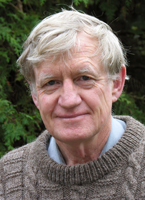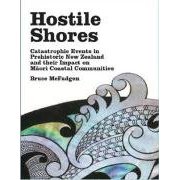Difference between revisions of "McFadgen Bruce"
| Line 1: | Line 1: | ||
Bruce Mcfadgen has been an archaeologist in New Zealand for over 45 years. His areas of interest include radiocarbon dating and the impact of tectonic dating in New Zealand culture, and he is currently employed by Victoria University in Wellington and is working on many projects there. He has published over 70 academic papers and texts, his most notable contribution being his Stout Fellowship under which he published '''Hostile Shores''', about the impact of natural disasters on early Maori civilization. | Bruce Mcfadgen has been an archaeologist in New Zealand for over 45 years. His areas of interest include radiocarbon dating and the impact of tectonic dating in New Zealand culture, and he is currently employed by Victoria University in Wellington and is working on many projects there. He has published over 70 academic papers and texts, his most notable contribution being his Stout Fellowship under which he published '''Hostile Shores''', about the impact of natural disasters on early Maori civilization. | ||
| − | + | He has currently been published by Clough & Associates, one of New Zealand's leading heritage research groups in archaeology. | |
== Early Education == | == Early Education == | ||
Revision as of 11:26, 25 February 2010
Bruce Mcfadgen has been an archaeologist in New Zealand for over 45 years. His areas of interest include radiocarbon dating and the impact of tectonic dating in New Zealand culture, and he is currently employed by Victoria University in Wellington and is working on many projects there. He has published over 70 academic papers and texts, his most notable contribution being his Stout Fellowship under which he published Hostile Shores, about the impact of natural disasters on early Maori civilization. He has currently been published by Clough & Associates, one of New Zealand's leading heritage research groups in archaeology.
Contents
Early Education
Before becoming an archaeologist, Mcfadgen became qualified in surveying by working for the Department of Lands and Survey until 1968, after which he finished his bachelor’s and master’s degrees in Anthropology.
He is a current resident of Wellington and research associate at Victoria University. He often lectures on prehistoric New Zealand and his various projects, and works with fellow archaeologist James Goff on many publications.
Awards and Credits
He initially came to Victoria University to receive his PhD in Geology in 1979. His first position as archaeologist was working for the Historic Sites Trust of New Zealand until 1987, during which time he received the ILFORD award for Aerial Archaeology in 1982 and was president of the New Zealand Archaeological Association (1986-1988) and also the Wellington branch of the Royal Society of New Zealand (1985-1987). As a member of the Royal Society, he has served on the Skinner Research Fund Committee since 1987. From 2001 to 2004 he was on the Advisory Board for the National Isotope Center. He then became employed as a scientist by the Department of Conservation, before retiring early in 2003 to begin work on his Stout Fellowship. He has since become the editor of the New Zealand Surveyor, a New Zealand publication by the Institute of Surveyors. While working for the Historic Sites Trust, he became well-published in his various articles specializing in geoarchaeology and stratigraphy. More recently, he has been studying urban areas in modern New Zealand and the histories behind them, such as the Chews Lane experiments.
Stout Fellowship
The Stout fellowship was established by the John David Stout trust in order to sponsor research projects into the society of New Zealand, and is an independent grant to well published and recognized scholars to research for a full twelve months at Victoria University. In 2003, he received the Stout fellowship for his research on tectonics and the Maori people, upon which he worked at the Stout Research Center. It was during this time that he researched and wrote his book Hostile Shores: Catastrophic Events in Prehistoric New Zealand and their Impact on Māori Coastal Communities. It references many studies, from his independent archaeology to the oral storytelling tradition of the Maori, and focuses on not only early volcanic activity on the islands of New Zealand but also the rash of 15th century tsunamis and their effect on the early populations.
Hostile Shores
Hostile Shores was published by Auckland University Press in 2003 under the name Bruce or BG Mcfadgen. The "big crunch" of 1400's tsunamis is the focus of his study. He concentrates on early colonization by the Polynesians through 18th century Europeans that inhabit the area. The coastal communities of the Maori people were shaped and affected not only physically but socially by all of these natural and man-made events. Mcfadgen incorporates not only his knowledge of tectonics and vulcanology but his specialties in radiocarbon dating, especially by correlating the samples of dating to various societies and the natural events that correspond with them. In this way he establishes the timeline of the given situation. He compares it to modern tectonic activity and its effect on modern cultures, and contrasts North and South Island coasts of the island. He identifies the catastrophic events as causes for loss of food sources and the need for migration of certain communities to more stable ground.
One NZ Foundation Controversy
There has been some controversy among the One New Zealand foundation, which claims to refute Mcfadgen’s work with evidence of pre-Maori settlement in the New Zealand Islands. The ONZF, however, is a society of some debate as an anti-Maori, protest group opposed to the government of New Zealand’s actions in settling with the Maori people. One of their main publications targets Mcfadgen several times, describing his work as “dismissive and simplistic”, however as a private group their findings have not been largely credited.
[1] [2] [3] [4] McFadgen, B.G. 2007. Hostile Shores: Catastrophic Events in Prehistoric New Zealand and their Impact on Māori Coastal Communities. Auckland University Press.

